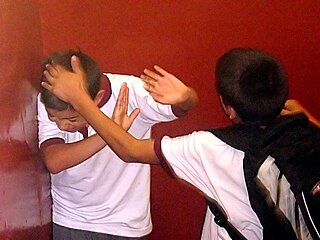
Conduct disorder (CD) is a mental disorder diagnosed in childhood or adolescence that presents itself through a repetitive and persistent pattern of behavior that includes theft, lies, physical violence that may lead to destruction, and reckless breaking of rules, in which the basic rights of others or major age-appropriate norms are violated. These behaviors are often referred to as "antisocial behaviors", and is often seen as the precursor to antisocial personality disorder; however, the latter, by definition, cannot be diagnosed until the individual is 18 years old. Conduct disorder may result from parental rejection and neglect and in such cases can be treated with family therapy, as well as behavioral modifications and pharmacotherapy. It may also be caused by environmental lead exposure. Conduct disorder is estimated to affect 51.1 million people globally as of 2013.
Antisocial personality disorder (ASPD) is a personality disorder defined by a chronic pattern of behavior that disregards the rights and well-being of others. People with ASPD often exhibit behavior that conflicts with social norms, leading to issues with interpersonal relationships, employment, and legal matters. The condition generally manifests in childhood or early adolescence, with a high rate of associated conduct problems and a tendency for symptoms to peak in late adolescence and early adulthood.

In sociology, a peer group is both a social group and a primary group of people who have similar interests (homophily), age, background, or social status. Members of peer groups are likely to influence each others' beliefs and behaviour.
Anti-social behaviours, sometimes called dissocial behaviours, are actions which are considered to violate the rights of or otherwise harm others by committing crime or nuisance, such as stealing and physical attack or noncriminal behaviours such as lying and manipulation. It is considered to be disruptive to others in society. This can be carried out in various ways, which includes, but is not limited to, intentional aggression, as well as covert and overt hostility. Anti-social behaviour also develops through social interaction within the family and community. It continuously affects a child's temperament, cognitive ability and their involvement with negative peers, dramatically affecting children's cooperative problem-solving skills. Many people also label behaviour which is deemed contrary to prevailing norms for social conduct as anti-social behaviour. However, researchers have stated that it is a difficult term to define, particularly in the United Kingdom where many acts fall into its category. The term is especially used in Irish English and British English.

A social skill is any competence facilitating interaction and communication with others where social rules and relations are created, communicated, and changed in verbal and nonverbal ways. The process of learning these skills is called socialization. Lack of such skills can cause social awkwardness.
Adolescent cliques are cliques that develop amongst adolescents. In the social sciences, the word "clique" is used to describe a group of 3 to 12 "who interact with each other more regularly and intensely than others in the same setting". Cliques are distinguished from "crowds" in that their members socially interact with one another more than the typical crowd. Crowds, on the other hand, are defined by reputation. Although the word 'clique' or 'cliquey' is often used in day-to-day conversation to describe relational aggression or snarky, gossipy behaviors of groups of socially dominant teenage girls, that is not always accurate. Interacting with cliques is part of normative social development regardless of gender, ethnicity, or popularity. Although cliques are most commonly studied during adolescence and in educational settings, they can exist in all age groups and settings.
School violence includes violence between school students as well as attacks by students on school staff and attacks by school staff on students. It encompasses physical violence, including student-on-student fighting, corporal punishment; psychological violence such as verbal abuse, and sexual violence, including rape and sexual harassment. It includes many forms of bullying and carrying weapons to school. The one or more perpetrators typically have more physical, social, and/or psychological power than the victim. It is a widely accepted serious societal problem in recent decades in many countries, especially where weapons such as guns or knives are involved.
Child psychopathology refers to the scientific study of mental disorders in children and adolescents. Oppositional defiant disorder, attention-deficit hyperactivity disorder, and autism spectrum disorder are examples of psychopathology that are typically first diagnosed during childhood. Mental health providers who work with children and adolescents are informed by research in developmental psychology, clinical child psychology, and family systems. Lists of child and adult mental disorders can be found in the International Statistical Classification of Diseases and Related Health Problems, 10th Edition (ICD-10), published by the World Health Organization (WHO) and in the Diagnostic and Statistical Manual of Mental Disorders, Fifth Edition (DSM-5), published by the American Psychiatric Association (APA). In addition, the Diagnostic Classification of Mental Health and Developmental Disorders of Infancy and Early Childhood is used in assessing mental health and developmental disorders in children up to age five.
Relational aggression, alternative aggression, or relational bullying is a type of aggression in which harm is caused by damaging someone's relationships or social status.
Oppositional defiant disorder (ODD) is listed in the DSM-5 under Disruptive, impulse-control, and conduct disorders and defined as "a pattern of angry/irritable mood, argumentative/defiant behavior, or vindictiveness." This behavior is usually targeted toward peers, parents, teachers, and other authority figures, including law enforcement officials. Unlike conduct disorder (CD), those with ODD do not generally show patterns of aggression towards random people, violence against animals, destruction of property, theft, or deceit. One-half of children with ODD also fulfill the diagnostic criteria for ADHD.

Social rejection occurs when an individual is deliberately excluded from a social relationship or social interaction. The topic includes interpersonal rejection, romantic rejection, and familial estrangement. A person can be rejected or shunned by individuals or an entire group of people. Furthermore, rejection can be either active by bullying, teasing, or ridiculing, or passive by ignoring a person, or giving the "silent treatment". The experience of being rejected is subjective for the recipient, and it can be perceived when it is not actually present. The word "ostracism" is also commonly used to denote a process of social exclusion.
Sociometric status is a measurement that reflects the degree to which someone is liked or disliked by their peers as a group. While there are some studies that have looked at sociometric status among adults, the measure is primarily used with children and adolescents to make inferences about peer relations and social competence.
Unpopularity is the opposite of popularity. Therefore, it is the quality of lacking acceptance or approval by one's peers or society as a whole.
Multisystemic therapy (MST) is an intense, family-focused and community-based treatment program for juveniles with serious criminal offenses who are possibly abusing substances. It is also a therapy strategy to teach their families how to foster their success in recovery.
Peer victimization is harassment or bullying that occurs among members of the same peer group. It is often used to describe the experience among children or young people of being a target of the aggressive and abusive behavior of other children, who are not siblings and not necessarily age-mates.

In 1993, American psychologist Terrie Moffitt described a dual taxonomy of offending behavior in an attempt to explain the developmental processes that lead to the distinctive shape of the age crime curve. Moffitt proposed that there are two main types of antisocial offenders in society: The adolescence-limited offenders, who exhibit antisocial behavior only during adolescence, and the life-course-persistent offenders, who begin to behave antisocially early in childhood and continue this behavior into adulthood. This theory is used with respect to antisocial behavior instead of crime due to the differing definitions of 'crime' among cultures. Due to similar characteristics and trajectories, this theory can be applied to both females and males.
Callous-unemotional traits (CU) are distinguished by a persistent pattern of behavior that reflects a disregard for others, and also a lack of empathy and generally deficient affect. The interplay between genetic and environmental risk factors may play a role in the expression of these traits as a conduct disorder (CD). While originally conceived as a means of measuring the affective features of psychopathy in children, measures of CU have been validated in university samples and adults.
Hostile attribution bias, or hostile attribution of intent, is the tendency to interpret others' behaviors as having hostile intent, even when the behavior is ambiguous or benign. For example, a person with high levels of hostile attribution bias might see two people laughing and immediately interpret this behavior as two people laughing about them, even though the behavior was ambiguous and may have been benign.
Deborah M. Capaldi is a developmental psychologist known for her research on at-risk male youth and the intergenerational transmission of substance use, antisocial behavior, intimate partner violence, and child abuse. She is a senior scientist at the Oregon Social Learning Center. Her current projects focus on child exposure to family violence and parenting practices of at-risk parents.

René Veenstra is professor of Sociology at the University of Groningen, the Netherlands. He was the scientific director of the Interuniversity Center for Social Science Theory and Methodology (ICS) from 2014 to 2023. The ICS is a joint graduate school of the sociology departments of the University of Groningen, Utrecht University, the Radboud University Nijmegen, and the University of Amsterdam.





